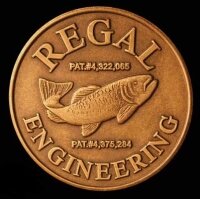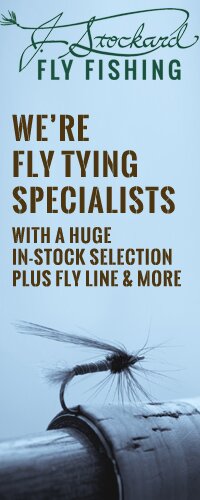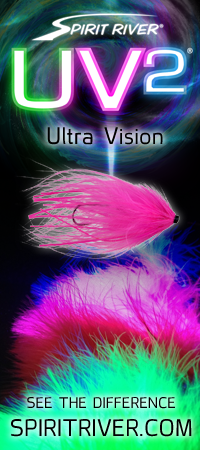 I recently had the pleasure of speaking to entomologist, fly tyer, and fly fisherman Dave McNeese. When Dave was young he traveled to New York to spend time with fly tyers like Art Flick, Elsie Darbee, Ray Smith, and Roy Steenrod. He has been doing scientific study on fish and insects since 1963. Dave has been instrumental in the study of the effect of UV products for fly tyers and is an expert in dying materials. He’s helped Bill Black of Spirit River tremendously with their UV2® line of fly tying materials. To read more about Spirit River UV2®, read my previous post on FrankenFly.
I recently had the pleasure of speaking to entomologist, fly tyer, and fly fisherman Dave McNeese. When Dave was young he traveled to New York to spend time with fly tyers like Art Flick, Elsie Darbee, Ray Smith, and Roy Steenrod. He has been doing scientific study on fish and insects since 1963. Dave has been instrumental in the study of the effect of UV products for fly tyers and is an expert in dying materials. He’s helped Bill Black of Spirit River tremendously with their UV2® line of fly tying materials. To read more about Spirit River UV2®, read my previous post on FrankenFly.
Dave says the UV factors in wildlife are used to a high degree. The structure of certain insect’s eyes that need pollen from a specific flower are guided by the UV signature within the flower itself. Predatory fish are like predatory birds as both use UV to hunt their prey. For example, the sparrow hawk can spot a mouse down on the ground in broad daylight by seeing the phosphorus in their urine trail they leave behind. In mayflies, females are amazingly protected by creation because they hardly have any UV, while males are often fed upon because of their color. Refraction is a big part of this. Light passes through and it develops other colors.
Jungle cock eyes are highly visible to steelhead because they contain a reflective polish for instance. Dave mentions you could actually replace synthetics in steelhead flies and use UV2® products instead because it will take care of the reflective color the synthetics show off. He has been testing this theory for years. One example is by adding a light colored material like a pinkish orange to the sides of his Hare’s Ear Nymph which has proved to be more effective in catching fish for him than a normal Hare’s Ear.
 Some UV materials can be used sparingly, like Spirit River’s UV2® Enhancer. When working with Enhancer it’s best to mix small amounts into some natural dubbing or mix it with natural fur like beaver or otter for example. You have to keep in mind that the entire body of a mayfly does not glow. Only small parts will have a UV reflective aspect to them. This is why you should only need a small amount mixed in instead of using only the UV2® Enhancer by itself. Spirit River does have their own UV2® dubbing mixes that have a mix of 15 to 30% UV2® already in them.
Some UV materials can be used sparingly, like Spirit River’s UV2® Enhancer. When working with Enhancer it’s best to mix small amounts into some natural dubbing or mix it with natural fur like beaver or otter for example. You have to keep in mind that the entire body of a mayfly does not glow. Only small parts will have a UV reflective aspect to them. This is why you should only need a small amount mixed in instead of using only the UV2® Enhancer by itself. Spirit River does have their own UV2® dubbing mixes that have a mix of 15 to 30% UV2® already in them.
Dave emphasizes that trout have incredible eye sight. Their eye sight is several times greater than a human’s. As a trout moves closer to its prey their color spectrum increases. This is good information to keep in mind when designing your flies.
Hopefully this gives you a basic idea of reflective UV in nature. This is the reason you see large lure companies developing more types of UV lures because they hire their own scientists to study and learn this information and relay that information when producing new enhanced products to catch fish. There is a world out there we don’t fully understand. If you’re not a scientist it’s difficult to obtain the information. Dave is lucky to be in contact with the leading entomologist at Oregon State University, Dr. Paul Hammond, who provides his expertise.
We are just now starting to scratch the surface in the fly fishing world with UV products and like “colors” it will take years of experimentation to learn what works and what doesn’t. It’s exciting to be in the beginning stages of this new development and I’m looking forward to where this might take us in the future.















You have a number of errors in your article. It is the European kestrel which targets field voles. The voles produce a urine that is highly reflective in the near-ultraviolet wavelengths. Since foliage – like the high grasses of the vole’s home – absorbs most of the UVA, the urine spots stand out as bright on dark. Phosphorescence and fluorescence are each different than UV reflectance.
Mayflies require UV markings for their mating swarms. Otherwise, how would they be able to select the proper gender and species in their one night of lovemaking. Females as well as males have species and gender specific markings. Among moths and butterflies, the males usually have the strong UV reflective patches; perhaps you got them confused.
Females as well as males have species and gender specific markings. Among moths and butterflies, the males usually have the strong UV reflective patches; perhaps you got them confused.
The natural materials we use in fly tying have differing percentages of UV reflectance. That difference has played a part in the successful flies we remember today.
Regards,
Overmywaders
The article was written from notes I made while speaking with Dave McNeese. I’ll have to ask him about your statements because I do not have enough knowledge to respond. Thank you for the comment and thank you for visiting.
I believe Mr. McNeese was using my book as a source, but got confused on details. It happens.
Regards,
Overmywaders
Oh ok, thank you Reed, I appreciate the information.
It’s easy to get a bit carried away by the apparent possibility of UV materials for fly tying. Problem is, both UVA and UVB are quickly attenuated to 1% or less in shallow freshwater by dissolved organic carbon and suspended particles. In all but the clearest rivers, there is little UV light penetrating more than about 10-20 cm (4-8 inches, for the metric challenged) below the surface. So have fun with the materials, but if lead eyes are part of your fly, you might as well leave off the UV materials. In nutrient poor tropical saltwaters, UV penetrance is a lot greater, so go nuts with UV materials on your bonefish and tarpon flies.
Thank you Ian, I appreciate the comment.
Ian,
I would appreciate your sources for your information.
If you look at the calculations and measurements in the following research, you may change your mind. The Penetration of UV into Natural Waters
or The attenuation of solar UV radiation in lakes and the role of dissolved organic carbon or Water Column Optics and Penetration of UVR
or you can watch this video of a SCUBA diver on a wreck in Lake Michigan at a depth of 270 feet. His fluorescent gear is brightly lit by the ambient UVA (excited by UVA wavelengths to re-emit at visible wavelengths) at that depth. Lake Michigan is not known as a particularly pristine body of water.
Lake Michigan Dive to 270 feet